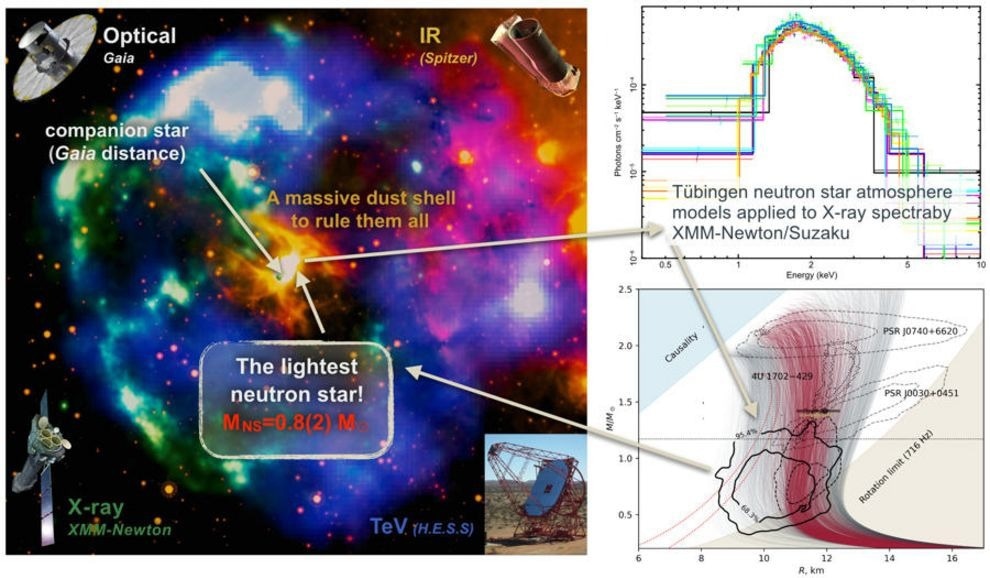Reviewed by Mila PereraOct 27 2022
Among the neutron stars discovered so far, the lightest neutron star has been found at the center of the supernova remnant HESS J1731-347.

Left: False-color image of the supernova remnant HESS J1731-347. In the center is the neutron star, which emits X-Rays and could therefore be observed by the XMM-Newton X-Ray telescope. In the middle of the dust envelope is the companion star observed by the Gaia telescope. All kinds of invisible light were measured, from infrared (orange; Spitzer telescope) to X-Rays (green, XMM-Newton telescope) and the ultrahigh-energy TeV band (blue; H.E.S.S. telescopes). Right: High-resolution X-Ray spectra of the neutron star from measurements by the XMM-Newton and Suzaku telescopes, which were used to determine the stellar mass. Image Credit: University of Tübingen
Dr. Victor Doroshenko, Dr. Gerd Pühlhofer, Dr. Valery Suleimanov, and Professor Andrea Santangelo from the High Energy Astrophysics section of the University of Tübingen’s Institute of Astronomy and Astrophysics discovered the object using X-Ray telescopes in space.
Based on calculations by the researchers, this star only has approximately half the mass of a regular neutron star. As a foundation for their calculations, the scientists applied new distance measurements to a companion star that the same team had previously detected. This enabled astrophysicists to stipulate the radius and mass of the neutron star with unparalleled accuracy.
Their findings have been reported in the latest issue of Nature Astronomy.
Neutron stars are birthed when regular stars possessing large masses “die” in a supernova explosion, explains the study’s lead author Victor Doroshenko. He refers to them as extreme objects considered celestial laboratories for examining basic physics.
“Neutron stars have yet unknown properties of matter; they have much higher density than atomic nuclei,” Doroshenko states. Settings such as these cannot be simulated in terrestrial labs.
Space-based observations of neutron stars with extreme properties such as the one we’ve just found, using X-Ray or other telescopes will allow us to solve the mysteries of super-dense matter—at least if we can solve challenges such as the inaccuracy of measurements over such distances that arises during observations. We have now succeeded in doing just that—pushing the knowledge about these mysterious objects a bit further.
Victor Doroshenko, Study Lead Author, High Energy Astrophysics Section, Institute of Astronomy and Astrophysics, University of Tübingen
The neutron star located at the center of the supernova remnant HESS J1731-347 was one of a few objects detected during gamma-ray measurements with the H.E.S.S. telescopes in Namibia and then explored using X-Ray telescopes from space, Doroshenko explains.
“Only then did the cooling neutron star become visible,” adds Gerd Pühlhofer.
This object's distinctiveness, as the researchers had observed previously, is that it is physically linked to another star. That star irradiates the dust cloud surrounding the neutron star, heats it, and makes it glow in infrared light.
The companion star was recently observed by the European Space Agency's Gaia space telescope, which supplied the researchers with precise distance measurements of both objects. The Gaia mission includes a high-precision three-dimensional (3D) optical survey of the sky.
“This allowed us to resolve previous inaccuracies and improve our models,” Pühlhofer said.
The mass and radius of the neutron star could be determined much more precisely than was previously possible.
Valery Suleimanov, Theoretical Astrophysicist, High Energy Astrophysics Section, Institute of Astronomy and Astrophysics, University of Tübingen
Suleimanov states that it is still unclear how the rare object was created. Andrea Santangelo adds that there are also uncertainties as to whether it is truly a neutron star or whether the object is a candidate for an even more unusual object made of odd quark matter.
This is currently the most promising quark or strange-matter star candidate we know of so far, even if its properties are consistent with those of a 'normal' neutron star.
Professor Andrea Santangelo, High Energy Astrophysics Section, Institute of Astronomy and Astrophysics, University of Tübingen
However, even if the object at the center of HESS J1731-347 is a neutron star, it still is a stimulating and mysterious object.
It allows us to probe the yet unexplored part of the parameter space in the mass-radius plane of neutron stars. This will enable us to put valuable constraints on the equation of state of dense matter, which is used to describe its properties.
Professor Andrea Santangelo, High Energy Astrophysics Section, Institute of Astronomy and Astrophysics, University of Tübingen
Journal Reference
Doroshenko, V., et al. (2022) A strangely light neutron star within a supernova remnant. Nature Astronomy. doi.org/10.1038/s41550-022-01800-1.